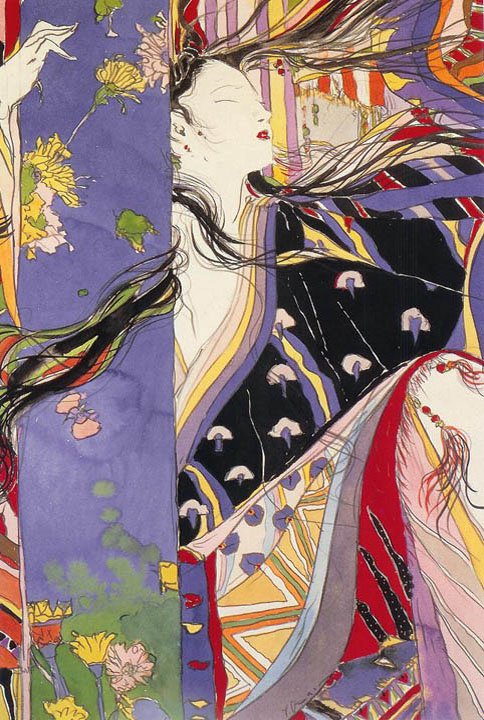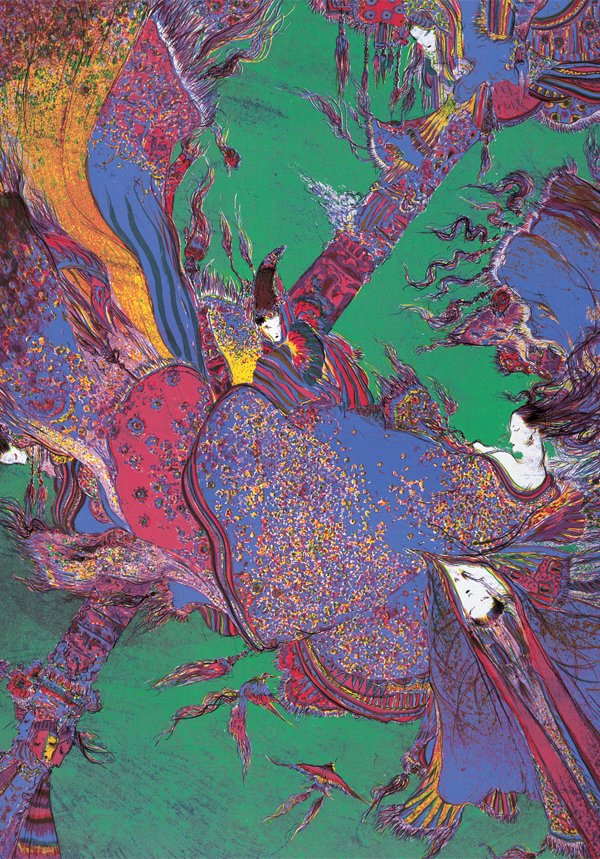

1/ From chapter 21, titled “The Maidens”, the story starts to focus on the new generation.
Genji has 3 children, in this order:
- Reizei: Genji’s son with Fujitsubo (Her Late Eminence), but to the world, he’s son of the late Kiritsubo Emperor (Genji’s father). Currently the Emperor.
- Yugiri: son of Aoi, Genji’s first wife. Aoi dies a short time after childbirth.
- The daughter, known as Akashi no Himegimi: Genji’s daughter with the Akashi Novice’s daughter, but she’s now raised by Murasaki.
Genji doesn’t have any children with Murasaki, the love of his life.
Chapter 21 is particularly interesting for the subject of education, and also shows the difference between Genji and his best friend To no Chujo, who has several children from different women.
Genji focuses on raising his children properly—he deliberately makes it difficult for his son Yugiri by promoting him to a lower rank than expected (6th rank instead of 4th rank) and making him work for it. Genji prioritises learning and good qualities for his children. He is not that different from rich and successful parents in modern day who don’t give their children a high position or the entire inheritance but make them work hard to prove themselves.
To no Chujo, in contrast, focuses more on ambitions. Among his children, the most notable at the moment are two daughters. One of them he has introduced to the Emperor—she is now the new Kokiden Consort, but Reizei, the Emperor, prefers the Ise Consort and makes her the Empress.
Having failed, he has ambitious plans for another daughter, known as Kumoi no Kari. Her mother (not the same as the Kokiden Consort’s) is married to the Inspector Grand Counsellor. The man treats his daughters like chess pieces. The plans aren’t going well, though, because the poor girl is interested in Yugiri.
2/ In chapter 21, Murasaki Shikibu raises the question of love vs social ambitions.
Reading The Tale of Genji as a woman, I can’t help seeing how shitty it was to be a woman in that time, even for ladies at court, who were literally at the top of society. Imagine being at the bottom.
3/ In these chapters, Genji and To no Chujo are rivals, and it is interesting that very early on in the novel, Murasaki Shikibu already sets up their rivalry—see the Aging Dame of Staff.
She sets things up so cleverly that, as I recently realised, some characters were “sneakily” introduced several chapters before they officially appeared, that their introductions were not noticed by a first-time reader.
4/ Yugiri, like his father and perhaps other men at court in general, is interested in 2 girls at the same time: To no Chujo’s daughter Kumoi no Kari, and a Gosechi dancer, daughter of Koremitsu (Genji’s confidant).
I’m going to be a spoilsport by pointing out, in case it wasn’t clear, that he and Kumoi no Kari are first cousins.
5/ As Murasaki Shikibu is a cruel writer who likes challenging and torturing her readers, Genji, after building some residences nearby, decides to build another house at Rokujo estate and moves there, away from court. Again, his women change “names”.
- Murasaki: Genji’s wife (after Aoi). Fujitsubo’s niece and daughter of the former His Highness of War, now Lord of Ceremonial. Resembles Fujitsubo. Previously referred to as the lady of Genji’s west wing or Genji’s darling. Associated with the colour purple. Genji and Murasaki live at the southeast quarter—associated with spring.
- Hanachirusato: sister of the former Reikeiden Consort. Associated with the village of falling flowers. Previously the lady in east pavilion. She now lives in the northeast quarter—associated with summer.
- The former Ise Consort, the Empress (Akikonomu): daughter of the late Rokujo Haven. I’m not sure why she moves here (what about the Emperor?), but she has the southwest quarter, which is where she once lived—associated with autumn.
- The Akashi Novice’s daughter (Akashi no Kimi): Genji meets her while in exile. She and Genji are second cousins, as his late mother is daughter of the Akashi Novice’s uncle. They have a daughter together, known as Akashi no Himegini. Previously known as the lady at Oi, now often called Akashi. She now moves to the estate and lives in the northwest quarter—associated with winter.
- Suetsumuhana: also called the red-nosed woman. The late Hitachi Prince’s daughter. Associated with the safflower because of its dye. In chapter 17, Genji moves her to the west wing of the east pavilion (Genji’s Nijo estate, at court). She doesn’t move to Rokujo estate.
6/ Following the chapter “The Maidens” is a chapter about another maiden—chapter 22, “Tamakazura”, translated as “The Tendril Wreath”.
Tamakazura is the nickname for the lost daughter of Yugao (twilight beauty) with To no Chujo.
In the chapter, Murasaki Shikibu leaves the current narrative to pick up a thread from earlier.
The nurse has been bringing up Tamakazura, without knowing anything about Yugao’s fate, but after her husband’s death, has to choose between accepting a suitor for Tamakazura and going to the city to help her find her father. The interesting part is the disagreement between her and Ukon, formerly Yugao’s gentlewoman and now Murasaki’s. The nurse wants to contact the father—To no Chujo. Ukon wants to inform Genji, because she herself works in Genji’s house.
Previously, there have been conflicts between the two because Ukon has to keep the secret about Yugao and Genji, whilst the nurse doesn’t tell her about the child. Now they disagree about what to do about Tamakazura.
Finally Genji wins, and the young woman moves in with Hanachirusato (the lady from the village of falling flowers).
But isn’t that wrong? His reasoning is that To no Chujo has lots of children to busy himself with already, and he himself has only 3, but who is he to decide? She is To no Chujo’s daughter—he deserves to know.
7/ I like that Genji is (usually) honest to Murasaki. He often downplays his feelings for other women, sometimes even dismisses them as unimportant, but generally still tells her about other women, about what he plans to do or who he intends to meet, etc.
In chapter 22, he tells her about Yugao, almost without restraint.
Yugao’s daughter Tamakazura is now known as the lady in the west wing, because she lives in the west wing of the northeast quarter (sharing a building with Hanachirusato).
8/ Genji tries to make it fair to everyone.
The women are not equal—Murasaki lives in the same building with him, the other women don’t, and he doesn’t move Suetsumuhana to the Rokujo estate. But he makes sure that all of them are taken care of and get everything they need, and sometimes visits them so they don’t feel neglected, even if, in the case of Suetsumuhana, he no longer cares about her.
The case of Suetsumuhana is particularly interesting, because Genji doesn’t feel attracted to her anymore and sometimes may even be unkind to her in his thoughts or behind her back. But he feels a duty to take care of her, which he does, despite getting nothing out of it, and he still visits her, as we see in chapter 23.
Suetsumuhana, under a lesser writer’s pen, might easily have become mere comic relief, or a two-dimensional character created only to prove a point about Genji’s goodness. But Murasaki Shikibu is a great writer, and in chapter 15 gives the character more complexity. Suetsumuhana is proud, stubborn, antiquated, and not very self-aware. She is an interesting character on her own.
No comments:
Post a Comment
Be not afraid, gentle readers! Share your thoughts!
(Make sure to save your text before hitting publish, in case your comment gets buried in the attic, never to be seen again).